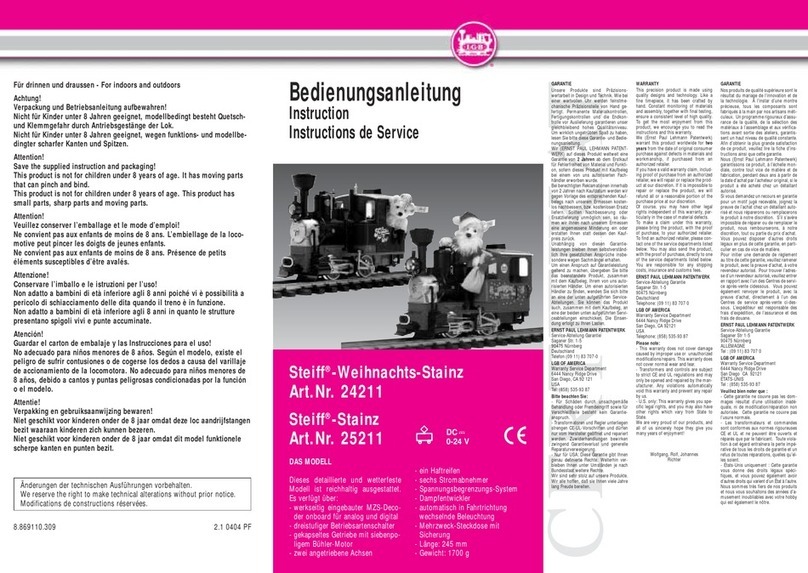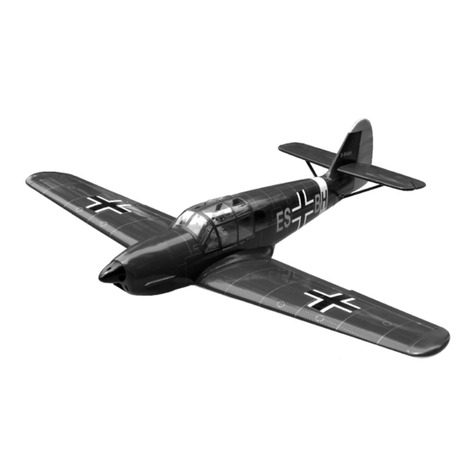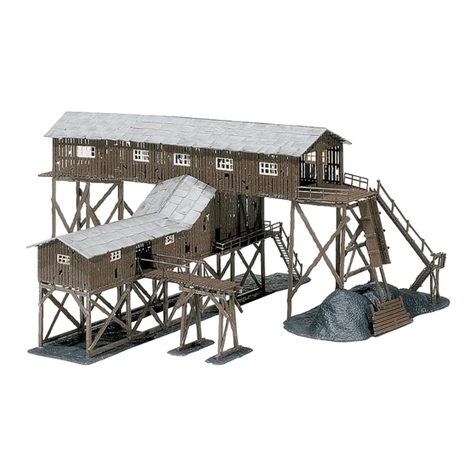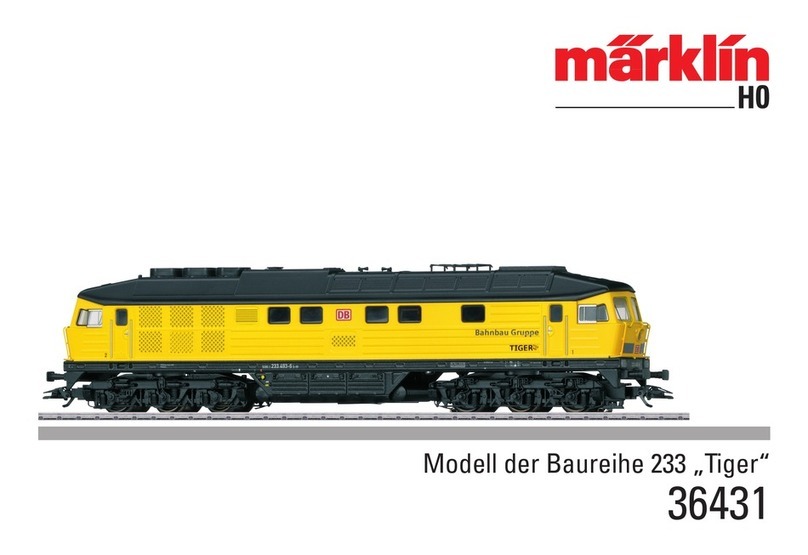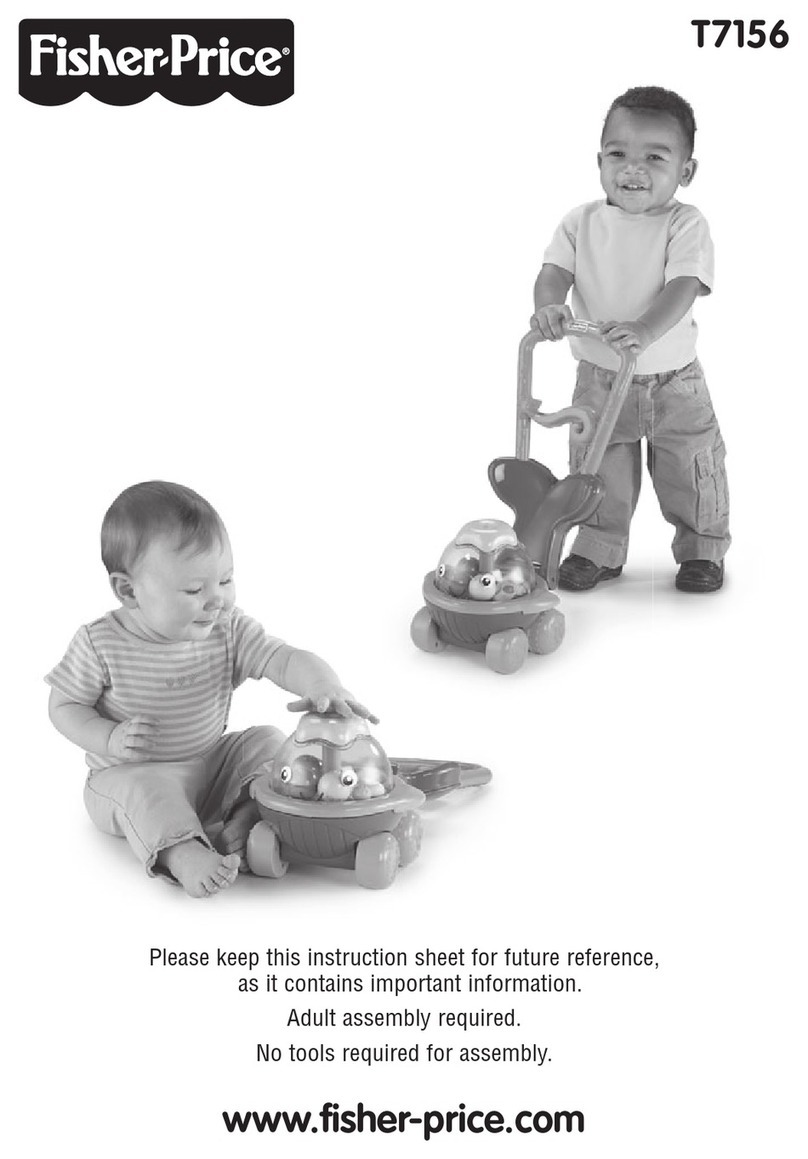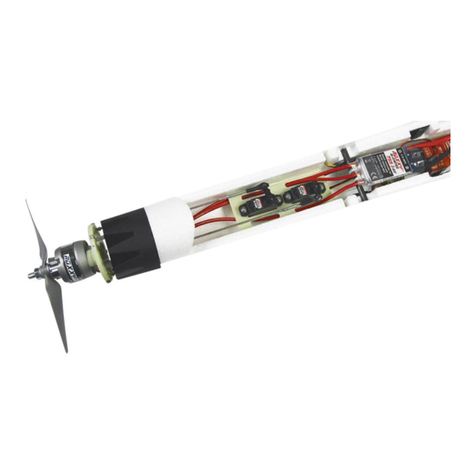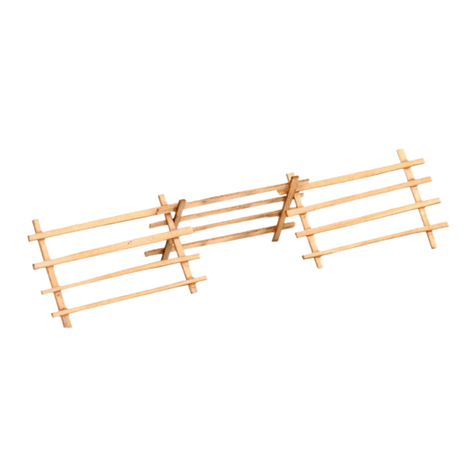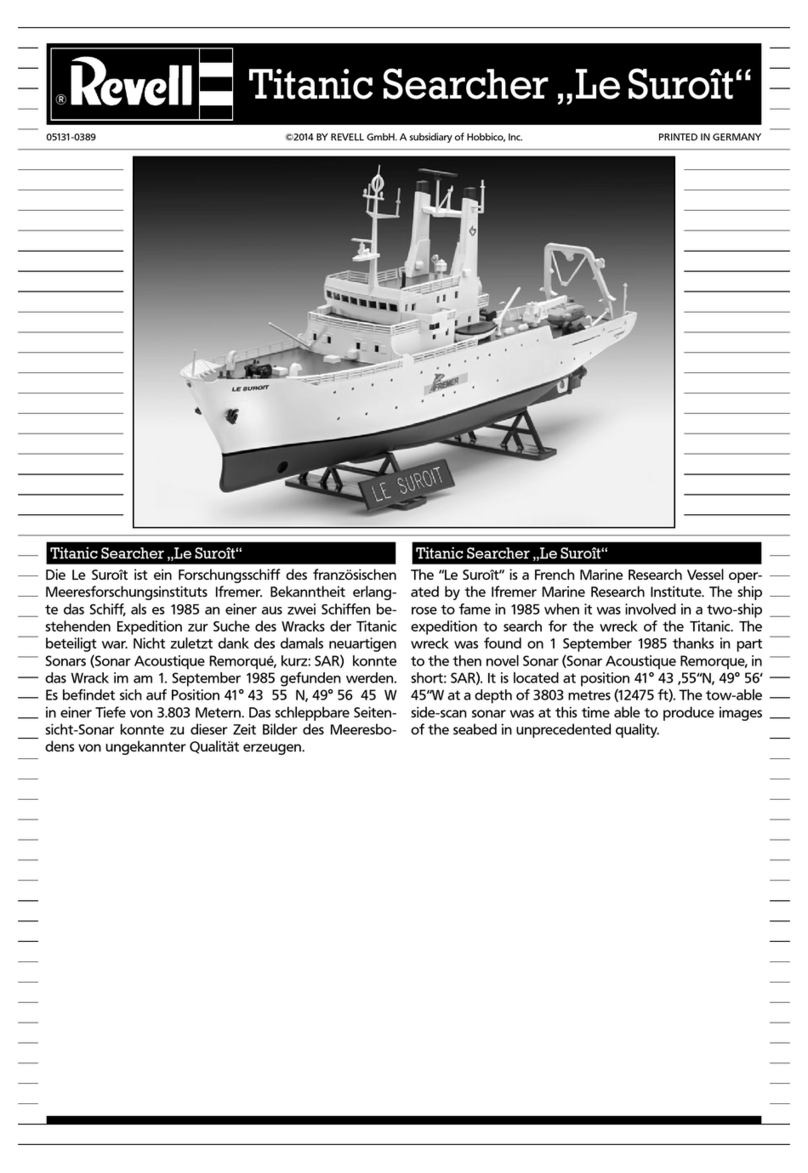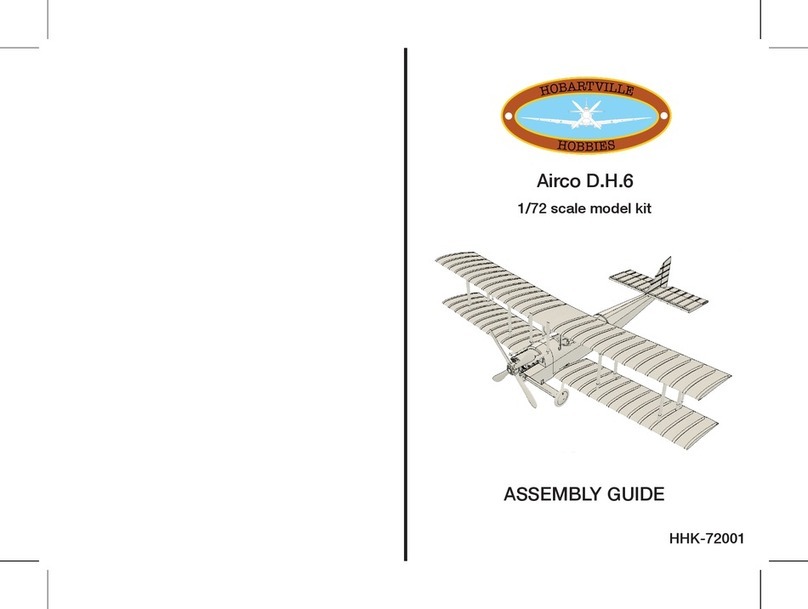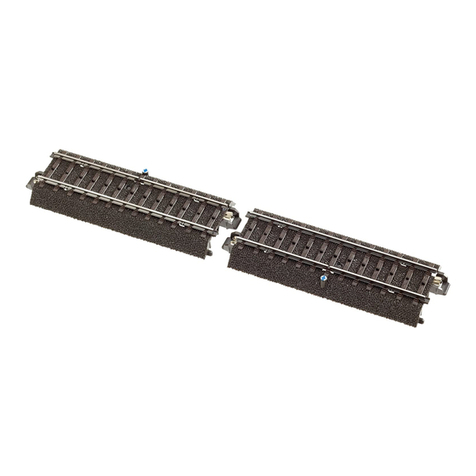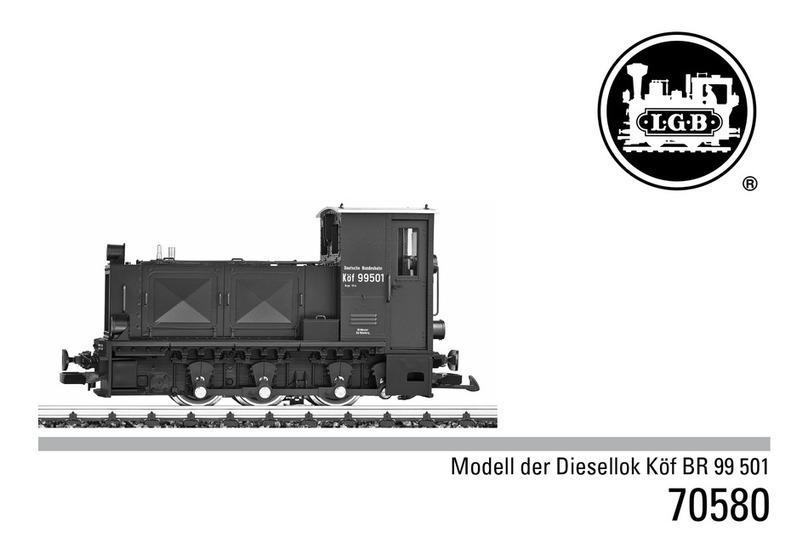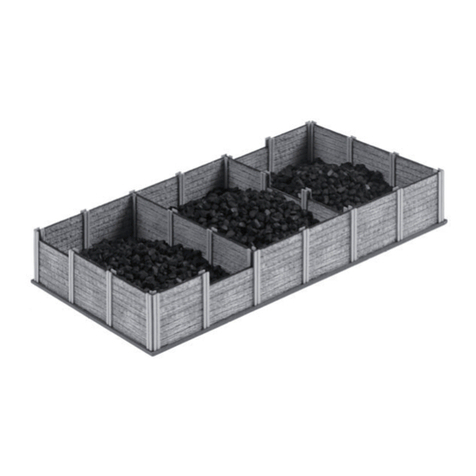Top Flite Models Beechcraft User manual

READTHROUGHTHIS MANUAL BEFORE STARTING CONSTRUCTION. IT CONTAINS IMPORTANT INSTRUCTIONS AND WARNINGS CONCERNINGTHE ASSEMBLY AND USE OFTHIS MODEL.
TOPZ0905 for TOPA0905 V1.0
Entire Contents © Copyright 2006
Wingspan: 72.5 in [1840mm]
Wing Area: 1525 sq in [97.6 dm2]
Weight: 17-19 lb [7.7-8.6 kg]
Wing Loading: 26-28 oz/sq ft
[80-90 g/dm2]
Length: 62.5 in [1590mm]
Radio: 6-Channel w/7 servos (minimum)
or
8/9-Channel w/9 servos (w/retracts)
Engines: 1.60 cu in [25 cc] two-stroke,
1.60 cu in [25 cc] four-stroke
WARRANTY.....Top Flite Models guarantees this kit to be free
from defects in both material and workmanship at the date of purchase.This warranty
does not cover any component parts damaged by use or modification.In no case shall
Top Flite’s liability exceed the original cost of the purchased kit. Further, Top Flite
reserves the right to change or modify this warranty without notice.
In that Top Flite has no control over the final assembly or material used for final
assembly, no liability shall be assumed nor accepted for any damage resulting from the
use by the user of the final user-assembled product. By the act of using the user-
assembled product, the user accepts all resulting liability.
If the buyer is not prepared to accept the liability associated with the use of this
product, the buyer is advised to return this kit immediately in new and unused condition
to the place of purchase.
To make a warranty claim send the defective
part or item to Hobby Services at the address:
Include a letter stating your name, return shipping address, as much contact
information as possible (daytime telephone number, fax number, e-mail address), a
detailed description of the problem and a photocopy of the purchase receipt. Upon
receipt of the package the problem will be evaluated as quickly as possible.
Hobby Services
3002 N. Apollo Dr. Suite 1
Champaign IL 61822 USA

TABLE OF CONTENTS
INTRODUCTION . . . . . . . . . . . . . . . . . . . . . . . . 2
SAFETY PRECAUTIONS. . . . . . . . . . . . . . . . . . 3
DECISIONSYOU MUST MAKE . . . . . . . . . . . . . 4
Radio Equipment . . . . . . . . . . . . . . . . . . . . . . . . 4
Engine Recommendations . . . . . . . . . . . . . . . . . 4
Retracts . . . . . . . . . . . . . . . . . . . . . . . . . . . . . . . 4
ADDITIONAL ITEMS REQUIRED. . . . . . . . . . . . 4
Required Hardware and Accessories . . . . . . . . . 4
Optional Supplies and Tools . . . . . . . . . . . . . . . . 4
IMPORTANT BUILDING NOTES . . . . . . . . . . . . 4
ORDERING REPLACEMENT PARTS. . . . . . . . . 5
KIT CONTENTS. . . . . . . . . . . . . . . . . . . . . . . . . 6
PREPARATIONS . . . . . . . . . . . . . . . . . . . . . . . . 7
BUILD THE WING . . . . . . . . . . . . . . . . . . . . . . . 7
Install the Flaps/Ailerons. . . . . . . . . . . . . . . . . . . 7
Install the Aileron Servos and Pushrods . . . . . . . 8
Install the Flap Servos and Pushrods . . . . . . . . . 9
Install the Wing Joiners. . . . . . . . . . . . . . . . . . . 10
Attach the Wings to the Fuselage . . . . . . . . . . . 11
Install the Struts . . . . . . . . . . . . . . . . . . . . . . . . 12
BUILD THE FUSELAGE. . . . . . . . . . . . . . . . . . 13
Install the Stabilizers, Elevators and Rudder . . . 13
INSTALLTHE LANDING GEAR . . . . . . . . . . . . 15
Fixed Landing Gear . . . . . . . . . . . . . . . . . . . . . 15
Fixed Tail Wheel . . . . . . . . . . . . . . . . . . . . . . . . 17
Tail Wheel Door Installation. . . . . . . . . . . . . . . . 17
Retractable Landing Gear. . . . . . . . . . . . . . . . . 18
Retractable Tail Wheel . . . . . . . . . . . . . . . . . . . 23
Tail Wheel Door Installation. . . . . . . . . . . . . . . . 24
Install the Retract Hardware . . . . . . . . . . . . . . . 26
Adjusting the Retractable Landing Gear . . . . . . 27
INSTALLTHE ENGINE & THROTTLE SERVO . 28
O.S. 1.60 Two-Stroke Engine. . . . . . . . . . . . . . . 28
O.S. 1.60 Four-Stroke Engine . . . . . . . . . . . . . . 29
Install the Fuel Tank for the
O.S. 1.60 Two-Stroke Engine . . . . . . . . . . . . 29
Install the Fuel Tank for the
O.S. 1.60 Four-Stroke Engine. . . . . . . . . . . . 30
Install the Cowl and Dummy Engine . . . . . . . . . 30
Install the Radio System . . . . . . . . . . . . . . . . . . 32
Finishing Touches. . . . . . . . . . . . . . . . . . . . . . . 35
GET THE MODEL READY TO FLY . . . . . . . . . . 36
Check the Control Directions. . . . . . . . . . . . . . . 36
Set the Control Throws . . . . . . . . . . . . . . . . . . . 36
Balance the Model (C.G.) . . . . . . . . . . . . . . . . . 36
Balance the Model Laterally . . . . . . . . . . . . . . . 37
PREFLIGHT. . . . . . . . . . . . . . . . . . . . . . . . . . . 37
Identify Your Model . . . . . . . . . . . . . . . . . . . . . . 37
Charge the Batteries. . . . . . . . . . . . . . . . . . . . . 37
Balance Propellers . . . . . . . . . . . . . . . . . . . . . . 37
Ground Check . . . . . . . . . . . . . . . . . . . . . . . . . 38
Range Check . . . . . . . . . . . . . . . . . . . . . . . . . . 38
ENGINE SAFETY PRECAUTIONS. . . . . . . . . . 38
AMA SAFETY CODE. . . . . . . . . . . . . . . . . . . . 38
IMAA SAFETY CODE . . . . . . . . . . . . . . . . . . . 39
CHECK LIST . . . . . . . . . . . . . . . . . . . . . . . . . . 40
FLYING . . . . . . . . . . . . . . . . . . . . . . . . . . . . . . 41
Takeoff . . . . . . . . . . . . . . . . . . . . . . . . . . . . . . . 41
Flight . . . . . . . . . . . . . . . . . . . . . . . . . . . . . . . . 42
Landing . . . . . . . . . . . . . . . . . . . . . . . . . . . . . . 42
1.60 Engine Mount Template. . . . . . . . . . . . . . . 43
INTRODUCTION
With its clean lines, negatively staggered wings, and
retractable landing gear, the natural aesthetic beauty
of the “Staggerwing” has made it an uncontested
classic airplane. Even today the Beechcraft Model 17
Staggerwing is comparable to modern private aircraft.
This classiest of classic airplanes transported military
generals and executives throughout the Second
World War and for years afterwards. Top Flite has
returned this vintage airplane to the modeling
community in the form of a “World Class”ARF that we
are sure will bring you hours of great fun.
For the latest technical updates or manual
corrections to the Staggerwing visit the Top Flite web
site at www.top-flite.com. Open the “Airplanes” link,
and then select the Staggerwing ARF. If there is new
technical information or changes to this model a
“tech notice” box will appear in the upper left corner
of the page.
AMA
We urge you to join the AMA (Academy of Model
Aeronautics) and a local R/C club. The AMA is the
governing body of model aviation and membership is
required to fly at AMA clubs.Though joining the AMA
provides many benefits, one of the primary reasons
to join is liability protection. Coverage is not limited to
flying at contests or on the club field. It even applies
to flying at public demonstrations and air shows.
Failure to comply with the Safety Code (excerpts
printed in the back of the manual) may endanger
insurance coverage. Additionally, training programs
and instructors are available at AMA club sites to help
you get started the right way. There are over 2,500
AMA chartered clubs across the country. Contact the
AMA at the address or toll-free phone number below:
Academy of Model Aeronautics
5151 East Memorial Drive
Muncie, IN 47302-9252
Tele. (800) 435-9262
Fax (765) 741-0057
Or via the Internet at:
www.modelaircraft.org
IMPORTANT!!!
Two of the most important things you can do to
preserve the radio-controlled aircraft hobby are to
avoid flying near full-scale aircraft and avoid flying
near or over groups of people.
IMAA
TheTop Flite Staggerwing is an excellent sport-scale
model and is eligible to fly in IMAA events.The IMAA
(International Miniature Aircraft Association) is an
organization that promotes non-competitive flying of
giant-scale models. If you plan to attend an IMAA
event, obtain a copy of the IMAA Safety Code by
contacting the IMAA at the address or telephone
number below, or by logging on to their web site at:
IMAA
205 S. Hilldale Road
Salina, KS 67401
(913) 823-5569
www.fly-imaa.org/imaa/sanction.html.
- 2 -

SCALE COMPETITION
Though the Top Flite Staggerwing is an ARF and
may not have the same level of detail as an “all-out”
scratch-built competition model, it is a scale model
nonetheless and is therefore eligible to compete in
the
Fun Scale
class in AMA competition (we receive
many favorable reports of Top Flite ARFs in scale
competition!).In Fun Scale, the “builder of the model”
rule does not apply. To receive the five points for
scale documentation, the only proof required that a
full-size aircraft of this type in this paint/markings
scheme did exist is a single sheet such as a kit box
cover from a plastic model, a photo, or a profile
painting, etc. If the photo is in black and white, other
written documentation of color must be provided.
Contact the AMA for a rule book with full details.
If you would like photos of full-size Staggerwings for
scale documentation, or if you would like to study the
photos to add more scale details, photo packs are
available from:
Bob’s Aircraft Documentation
3114 Yukon Ave
Costa Mesa, CA 92626
Telephone: (714) 979-8058
Fax: (714) 979-7279
www.bobsairdoc.com
1.Your Staggerwing should not be considered a toy, but
rather a sophisticated, working model that functions very
much like a full-size airplane. Because of its
performance capabilities, the Staggerwing, if not
assembled and operated correctly, could possibly cause
injury to yourself or spectators and damage to property.
2. You must assemble the model according to the
instructions. Do not alter or modify the model, as
doing so may result in an unsafe or unflyable model.
In a few cases the instructions may differ slightly from
the photos.In those instances the written instructions
should be considered as correct.
3.You must take time to build straight,true and strong.
4.You must use an R/C radio system that is in first-
class condition, and a correctly sized engine and
components (fuel tank, wheels, etc.) throughout the
building process.
5. You must correctly install all R/C and other
components so that the model operates correctly on
the ground and in the air.
6. You must check the operation of the model before
every flight to insure that all equipment is operating and
that the model has remained structurally sound.Be sure
to check clevises or other connectors often and replace
them if they show any signs of wear or fatigue.
7. If you are not an experienced pilot or have not
flown this type of model before, we recommend that
you get the assistance of an experienced pilot in your
R/C club for your first flights. If you’re not a member
of a club, your local hobby shop has information
about clubs in your area whose membership
includes experienced pilots.
8. While this kit has been flight tested to exceed
normal use, if the plane will be used for extremely
high stress flying, such as racing, or if an engine
larger than one in the recommended range is used,
the modeler is responsible for taking steps to
reinforce the high stress points and/or substituting
hardware more suitable for the increased stress.
9.WARNING: The cowl, landing gear covers and wing
struts included in this kit are made of fiberglass, the
fibers of which may cause eye, skin and respiratory
tract irritation. Never blow into a part to remove
fiberglass dust, as the dust will blow back into your
eyes.Always wear safety goggles, a particle mask and
rubber gloves when grinding, drilling and sanding
fiberglass parts.Vacuum the parts and the work area
thoroughly after working with fiberglass parts.
Remember: Take your time and follow the
instructions to end up with a well-built model that
is straight and true.
We, as the kit manufacturer, provide you with a top
quality, thoroughly tested kit and instructions, but
ultimately the quality and flyability of your finished
model depends on how you build it; therefore, we
cannot in any way guarantee the performance of
your completed model, and no representations
are expressed or implied as to the performance or
safety of your completed model.
PROTECTYOUR MODEL,
YOURSELF & OTHERS
FOLLOW THESE IMPORTANT
SAFETY PRECAUTIONS
- 3 -

DECISIONSYOU MUST MAKE
This is a partial list of items required to finish the
Staggerwing that may require planning or decision
making before starting to build. Order numbers are
provided in parentheses.
RADIO EQUIPMENT
❏ 6-channel w/7 servos (6- 50oz/in, 1- 30oz/in) or
(with retracts) 8/9-channel w/9 servos (6- 50oz/in,
2- 30oz/in, 1- 90oz/in)
❏ 2 - 6" [150mm] servo extension (HCAM2701 for
Futaba®)
❏ 2 - 12" [300mm] servo extension (HCAM2711
for Futaba)
❏ 2 - Y-harness (HCAM2751 for Futaba)
❏ 1000 mAh battery (minimum)
❏ 6 - 54 oz/in servos (2-tail, 2-flaps, 1-rudder,
1-elevator)
❏ 2 - 30 oz/in servos (1-throttle, 1-retracts)
ENGINE RECOMMENDATIONS
The recommended engine for the Staggerwing is an
O.S.®1.60 two-stroke or four-stroke.
❏ For the 2-stroke engine we used the Bisson
Pitts muffler. (BISG4116)
❏ The O.S. 1.60 4-stroke engine can use the O.S.
Flex-pipe. (OSMG2672)
RETRACTS
If you choose to put retracts on your Staggerwing, we
used the following:
❏ Robart #530STAG Retracts (ROBQ0536)
❏ Robart #188VR Air Control Kit Standard with VR
Valve (ROBQ2302)
❏ Robart #169 Pressure Tubing (ROBQ2369)
❏ Robart #121 Scale Retract Tail Wheel (ROBQ2210)
❏ 90 oz-in Servo (such as the Futaba S3305,
FUTM0035 for the tail wheel)
ADDITIONAL ITEMS REQUIRED
ADHESIVES & BUILDING SUPPLIES
This is the list of Adhesives and Building Supplies
that are required to finish the Staggerwing.
❏ 1/2 oz. [15g] Thin Pro™CA (GPMR6001)
❏ 1 oz. [30g] Medium Pro CA+ (GPMR6008)
❏ Pro 30-Minute Epoxy (GPMR6047)
❏ Pro 6-Minute Epoxy (GPMR6045)
❏ R/C Foam Rubber (1/4" [6mm] - HCAQ1000
❏ 3' [900mm] Standard Silicone Fuel
Tubing (GPMQ4131)
❏ Drill Bits: 1/16" [1.6mm], 5/64" [2mm], 3/32"
[2.4mm], 7/64" [2.8mm], 1/8" [3.2mm], 9/64"
[3.6mm], 5/32" [4mm], 3/16" [4.8mm]
❏ 4-40 Tap and Drill Set (GPMR8101)
❏ 8-32 Tap and Drill Set (GPMR8103)
❏ Small T-Pins (100, HCAR5100)
❏ #1 Hobby Knife (HCAR0105)
❏ #11 Blades (5-pack, HCAR0211)
❏ Stick-On Segmented Lead Weights (GPMQ4485)
❏ Silver Solder w/Flux (GPMR8070)
❏ 21ST Century®Sealing Iron (COVR2700)
❏ 4 oz. [113g] Aerosol CA Activator (GPMR634)
❏ CA Applicator Tips (HCAR3780)
❏ Epoxy Brushes (6, GPMR8060)
❏ Mixing Sticks (50, GPMR8055)
❏ Mixing Cups (GPMR8056)
❏ Microballoons (TOPR1090)
❏ ThreadlockerThread Locking Cement (GPMR6060)
OPTIONAL SUPPLIES & TOOLS
Here is a list of optional tools mentioned in the
manual that will help you build the Staggerwing.
❏ Hobbico®Duster™Compressed Air (HCAR5500)
❏ Masking Tape (TOPR8018)
❏ Denatured Alcohol (for epoxy clean up)
❏ Panel Line Pen (TOPQ2510)
❏ Rotary Tool (such as Dremel)
❏ Rotary Tool Reinforced Cut-OffWheel (GPMR8020)
❏ Servo Horn Drill (HCAR0698)
❏ Hobby Heat™Micro Torch (HCAR0750)
❏ AccuThrow™Deflection Gauge (GPMR2405)
❏ Precision Magnetic Prop Balancer (TOPQ5700)
❏ CG Machine™(GPMR2400)
❏ Dead Center™Engine Mount Hole
Locator (GPMR8130)
IMPORTANT BUILDING NOTES
•There are two types of screws used in this kit:
Sheet metal screws are designated by a number
and a length. For example #6 x 3/4" [19mm]
This is a number six screw that is
3/4" [19mm] long.
Machine screws are designated by a number, threads
per inch, and a length.For example 4-40 x 3/4" [19mm]
This is a number four screw that
is 3/4" [19mm] long with forty
threads per inch.
Socket head cap screws are designated by a
number, threads per inch and a length.For example
4-40 x 3/4" [19mm]
This is a number four screw that
is 3/4" [19mm] long with forty
threads per inch
.
•When you see the term “test fit” in the instructions, it
means that you should first position the part on the
assembly without using any glue, then slightly modify
or custom fit the part as necessary for the best fit.
•Whenever the term “glue” is written, you should rely
upon your experience to decide what type of glue to
use. When a specific type of adhesive works best for
that step, the instructions will make a recommendation.
- 4 -

•Whenever just epoxy is specified, you may use
either 30-minute (or 45-minute) epoxy or 6-minute
epoxy. When 30-minute epoxy is specified, it is
highly recommended that you use only 30-minute
(or 45-minute) epoxy, because you will need the
working time and/or the additional strength.
•Photos and sketches are placed before the step they
refer to. Frequently you can study photos in following
steps to get another view of the same parts.
•The Staggerwing is factory-covered with Dark Red
Top Flite MonoKote®film (TOPQ0218 for a six foot
roll).Should repairs ever be required, MonoKote can
be patched with additional MonoKote purchased
separately. MonoKote is packaged in six-foot rolls,
but some hobby shops also sell it by the foot.If only
a small piece of MonoKote is needed for a minor
patch, perhaps a fellow modeler would give you
some. MonoKote is applied with a model airplane
covering iron, but in an emergency a regular iron
could be used. A roll of MonoKote includes full
instructions for application.
METRIC CONVERSIONS
To convert inches to millimeters, multiply inches by 25.4
ORDERING REPLACEMENT PARTS
Replacement parts for theTop Flite Staggerwing are
available using the order numbers in the
Replacement Parts List that follows. The fastest,
most economical service can be provided by your
hobby dealer or mail-order company.
To locate a hobby dealer, visit the Hobbico web site
at www.hobbico.com. Choose “Where to Buy” at the
bottom of the menu on the left side of the page.
Follow the instructions provided on the page to
locate a U.S., Canadian or International dealer.
Parts may also be ordered directly from Hobby
Services by calling (217) 398-0007, or via facsimile
at (217) 398-7721, but full retail prices and shipping
and handling charges will apply. Illinois and Nevada
residents will also be charged sales tax. If ordering
via fax, include a Visa®or MasterCard®number and
expiration date for payment.
Mail parts orders and payments by personal check to:
Hobby Services
3002 N Apollo Drive, Suite 1
Champaign IL 61822
Be certain to specify the order number exactly as
listed in the Replacement Parts List. Payment by
credit card or personal check only; no C.O.D.
If additional assistance is required for any reason
contact Product Support at:
(217) 398-8970
productsuppor[email protected]
REPLACEMENT PARTS LIST
Description How to purchase
Missing pieces Contact Product Support
Instruction manual Contact Product Support
Full-size plans Not available
Order # Description
TOPA1680........Top Wing w/Joiner
TOPA1681........Bottom Wing
TOPA1682........Fuselage
TOPA1683........Rudder w/Hinges
TOPA1684........Horizontal Stabilizer
TOPA1685........Landing Gear w/Tailwheel
TOPA1686........Gear Doors & Wheel Covers
w/Actuating Wires
TOPA1687........Cowl
TOPA1688........Cockpit Floor w/ Seat Backs
TOPA1689........Tail Cone
TOPA1690........Horizontal Stabilizer Tubes
TOPA1691........Interplane Wing Strut Mounts
TOPA1692........Interplane Wing Strut
TOPA1693........Wing Mounting Blades
.4mm = 1/64"
.8mm = 1/32"
1.6mm = 1/16"
2.4mm = 3/32"
3.2mm = 1/8"
4mm = 5/32"
4.8mm = 3/16"
6.4mm = 1/4"
9.5mm = 3/8"
12.7mm = 1/2"
15.9mm = 5/8"
19mm = 3/4"
25.4mm = 1"
50.8mm = 2"
76.2mm = 3"
152.4mm = 6"
304.8mm = 12"
381mm = 15"
457.2mm = 18"
533.4mm = 21"
609.6mm = 24"
762mm = 30"
914.4mm = 36"
- 5 -

- 6 -
2
22
11
14 15
17
18
16
19
20
21
10 9
8
76
55
4
3
1
12 13
KIT CONTENTS
1. Fuselage
2. Cowl
3. Tail Cone
4. Rudder
5. Stab with Elevators
6. Elevator Control Wire
7. Tail Wheel Hardware
8. Pilot
9. Fuel Tank
10. Pull-Pull Wire with Hardware
11. Spinner
12. Top Right Wing with Aileron
13. Top Left Wing with Aileron
14. Bottom Right Wing with Flap
15. Bottom Left Wing with Flap
16. Struts
17. Main Wheels
18. Seat Backs
19. Tail Wheel Doors
20. Landing Gear Doors
21. Cockpit Floor
22. Dummy Engine
To convert inches to millimeters, multiply inches by 25.4

- 7 -
PREPARATIONS
❏1. If you have not done so already, remove the
major parts of the kit from the box and inspect for
damage.If any parts are damaged or missing, contact
Product Support at the address or telephone number
listed in the “Kit Contents” section on page 6.
❏2.Remove the tape and separate the ailerons and
flaps from the wing and the elevators from the stab.
Use a covering iron with a covering sock on high heat
to tighten the covering if necessary. Apply pressure
over sheeted areas to thoroughly bond the covering
to the wood.
BUILD THE WING
Install the Flaps/Ailerons
Do the bottom right wing first so your work
matches the photos the first time through.
❏❏❏❏1.Drill a 3/32" [2mm] hole, 1/2" [13mm] deep
in the center of each hinge slot to allow the CA to“wick”
in. Follow-up with a #11 blade to clean out the slots.
Hint: If you have one, use a high-speed rotary tool to
drill the holes.
❏❏❏❏2. Use a sharp #11 blade to cut a strip of
covering from the hinge slots in the wing and aileron.
❏❏❏❏3. Cut sixteen 1" x 1"
[25mm x 25mm] hinges from a
CA hinge strip. Snip off the
corners so they go in easier.
Note:The following steps refer to the installation of the
flaps/ailerons. The bottom wing of the Staggerwing
has flaps.The top wing has ailerons. If you look at the
location of the hinge slots of each you will see the
flaps are hinged off the centerline of the flap and the
aileron is hinged on the centerline.
❏❏❏❏4. Test fit the flap/aileron to the wing with
the hinges. If the hinges don’t remain centered, stick a
pin through the middle of the hinge to hold it in position.
❏❏❏❏5.Remove any pins you may have inserted
into the hinges. Adjust the flap / aileron so there is a
small gap between the LE of the aileron and the wing.
The gap should be small, just enough to see light
through or to slip a piece of paper through.
❏❏❏❏6.Apply six drops of thin CA to the top and
bottom of each hinge. Do not use CA accelerator.
After the CA has fully hardened, test the hinges by
pulling on the aileron.
❏7.Repeat steps 1- 6 for the left wing panel and the
two wing panels for the top wing.

Install the Aileron Servos and Pushrods
❏❏1. Glue two 5/16" x 1/2" x 11/16" [8mm x 13mm x
18mm] hardwood blocks to the servo cover. Position
the blocks so the servo fits between the blocks.
❏❏2. Drill a 1/16" [1.6mm] hole through the servo
cover into the center of the servo mounting blocks.
Install and then remove a #2 x 3/8" [10mm] wood
screw into the holes you drilled. Apply a drop of thin
CA into the holes to harden the threads.Once the glue
has cured, install the screws into the servo cover.
❏❏3. Install a 12" [305mm] servo extension onto
the servo lead. Secure the extension to the lead with
tape, a piece of shrink tube or some other method to
keep them from coming unplugged.
❏❏4. Place the servo onto the servo mounting
blocks. Drill through the servo mounting holes with a
1/16" [1.6mm] drill bit. Remove the servo from the
servo cover. Install and then remove a servo
mounting screw into each of the holes you have
drilled. Apply a drop of thin CA into the holes to
harden the threads. Once the glue has cured, install
the servo onto the servo cover using the hardware
included with your servo. Center the servo and then
install a servo arm as shown.
❏❏5. Inside the servo bay a string is taped.Tie the
string to the servo extension. Pull the string and the
servo lead through the wing.Untie the string from the
lead and insert the lead through the small hole on the
top of the wing at the root.Tape the lead to the wing
to prevent it from falling back into the wing.
❏❏6. Place the servo cover onto the wing. The
opening for the servo arm should be pointed
towards the wingtip. Drill a 1/16" [1.6mm] hole
Did you know…At the height of the Great
Depression, aircraft executive Walter H. Beech
and airplane designer T.A.“Ted”Wells joined forces
to collaborate on a project many considered
foolhardy—a large, powerful, and fast biplane built
specifically for the business executive. The Beech
Model 17, popularly known as the “Staggerwing,”
was first flown on November 4, 1932.
- 8 -

through each corner of the cover. Remove the cover.
Then, install and remove a #2 x 3/8" [10mm] screw
into the holes you drilled. Apply a drop of thin CA into
the holes to harden the threads. Once the glue has
hardened, mount the servo cover with #2 x 3/8"
[10mm] screws and #2 flat washers.
❏❏7.Place a nylon control horn in line with the outer
hole in the servo arm. When positioned properly the
control horn will rest on a hardwood plate in the aileron.
Mark the location of the mounting holes onto the
aileron.Drill a 1/16" [1.6mm] hole on the marks, drilling
through the plywood plate
but not
through the top of
the aileron. Insert and remove a #2 x 3/8” [10mm]
screw into each of the holes. Apply a couple drops of
thin CA into the holes to harden the threads. Once the
glue has hardened attach the horn to the aileron with
two #2 x 3/8" [10mm] screws.
❏❏8. Screw a nylon clevis onto a .074 x 6" [152mm]
threaded wire 20 turns.Slide a nylon clevis retainer onto
the clevis.Install the clevis into the second hole from the
end of the control horn.Then, slide the silicone retainer
over the clevis. Drill a 5/64 [2mm] hole in the outer hole
of the servo arm. Center the servo and the aileron.With
a fine tip marker, mark the wire where it aligns with the
outer hole of the servo arm. Make a 90 degree bend on
the mark. Cut the wire so the wire is 3/8” [10mm] in
length after the bend.Insert the wire into the servo arm
and lock it in place with a nylon Faslink.
❏9. Repeat steps 1-8 for the left wing panel.
Install the Flap Servos and Pushrods
❏❏1. Glue two 5/16" x 1/2" x 11/16" [8mm x 13mm x
18mm] hardwood blocks to the servo cover. Position
the blocks so the servo fits between the blocks.
❏❏2. Drill a 1/16" [1.6mm] hole through the servo
cover into the center of the servo mounting blocks.
Install and then remove a #2 x 3/8" [10mm] wood
screw into the holes you drilled. Apply a drop of thin
CA into the holes to harden the threads.Once the glue
has cured, install the screws into the servo cover.
❏❏3.Install a 6" [152mm] servo extension onto the
servo lead. Secure the extension to the lead with
tape, a piece of shrink tube or some other method to
keep them from coming unplugged.
❏❏4. Place the servo onto the servo mounting
blocks. Drill through the servo mounting holes with a
1/16" [1.6mm] drill bit. Remove the servo from the
servo cover. Install and then remove a servo
mounting screw into each of the holes you have
drilled. Apply a drop of thin CA into the holes to
harden the threads. Once the glue has cured, install
the servo onto the servo cover using the hardware
included with your servo. Center the servo and then
offset the servo arm as shown.
❏❏5. Inside the servo bay a string is taped.Tie the
string to the servo extension. Pull the string and the
servo lead through the wing.Untie the string from the
lead and insert the lead through the small hole on the
top of the wing at the root.Tape the lead to the wing
to prevent it from falling back into the wing.
❏❏6. Place the servo cover onto the wing. The
opening for the servo arm should be pointed
towards the wing root on the right wing. (When
installing the left wing the opening will be towards the
wing tip). Drill a 1/16" [1.6mm] hole through each
corner of the cover. Remove the cover. Then, install
and remove a #2 x 3/8" [10mm] screw into the holes
you drilled. Apply a drop of thin CA into the holes to
harden the threads. Once the glue has hardened,
mount the servo cover with #2 x 3/8" [10mm] screws
and #2 flat washers.
- 9 -
FASLINK
2-56 (.074")
PUSHROD WIRE
SERVO
HORN

❏❏7. Place a nylon control horn backwards from
what would be considered the normal mounting
position, in line with the outer hole in the servo arm.
When positioned properly the control horn will rest
on a hardwood plate in the flap. Mark the location of
the mounting holes onto the flap. Drill a 1/16"
[1.6mm] hole on the marks, drilling through the
plywood plate
but not
through the top of the flap.
Insert and remove a #2 x 3/8" [10mm] screw into
each of the holes. Apply a couple drops of thin CA
into the holes to harden the threads. Once the glue
has hardened, attach the horn to the aileron with two
#2 x 3/8" [10mm] screws.
❏❏8. Screw a nylon clevis onto a .074 x 6” [152mm]
threaded wire 20 turns.Slide a nylon clevis retainer onto
the clevis.Install the clevis into the second hole from the
end of the control horn.Then, slide the silicone retainer
over the clevis.Drill a 5/64" [2mm] hole in the outer hole
of the servo arm. Center the servo and the flap. With a
fine tip marker, mark the wire where it aligns with the
outer hole of the servo arm. Make a 90 degree bend on
the mark. Cut the wire so the wire is 3/8" [10mm] in
length after the bend.Insert the wire into the servo arm
and lock it in place with a nylon Faslink.
❏9. Repeat steps 1-8 for the left wing panel.
Install the Wing Joiners
❏❏1. Locate three aluminum wing joiners. Slide
one joiner completely into the joiner pocket of the
lower right wing. The lower wing is the shorter wing
panel with the flaps.
❏❏2.Draw a line on the joiner where it extends out of
the joiner pocket. Roughen the portion of the joiner that
extends into the joiner pocket with 80-grit sandpaper.
❏❏3. Apply 30-minute epoxy to the inside of the
joiner pocket and the roughened end of the
aluminum joiner. Insert the joiner into the joiner
pocket. Be sure to insert the joiner fully into the
pocket. Clean any excess epoxy away from the wing
and joiner with rubbing alcohol.
Did you know…The Model 17s could achieve
a top speed of 201 miles per hour (323 kilometers
per hour), which made it faster than most military
aircraft of the era.Staggerwing’s speed also made
it the darling of the air racers of the 1930s.An early
version of Model 17 won the 1933 Texaco Trophy
Race. In 1935, a British diplomat, Capt. H.L.
Farquhar, successfully flew around the world in a
Model B17R, traveling 21,332 miles (34,331
kilometers) from New York to London, by way of
Siberia, Southeast Asia, the Middle East, North
Africa and back across Europe. Aviatrices Louise
Thaden and Blanche Noyes won the 1936
Bendix Trophy Race in a Model C17R
Staggerwing.Thaden also won the Harmon Trophy
for her achievement. Aviatrix Jackie Cochran set
a women’s speed record of 203.9 mph,
established an altitude record of over 30,000 feet
(9.144 meters), and finished third in the 1937
Bendix Trophy Race, all while flying a special
Model D17W Staggerwing.
- 10 -

- 11 -
❏❏4. Using 30-minute epoxy, glue two nylon anti-
rotation dowels into the holes at the root of the wing.
Glue them in so 1/2" of the dowels extends from
the wing.
❏5. Repeat steps 1-4 for the other wing.
❏6. Test fit a 3/8" x 2-1/2" [10mm x 64mm] wood
dowel into the hole at the leading edge of the top
wing. Push it into the wing, making sure it catches in
the hole further inside of the wing. Once you are
satisfied with the fit, epoxy them in place.Repeat this
for the other wing panel.
❏7. Glue the remaining wing joiner into the joiner
pocket of the top left wing using the same procedure
used for installing them in the bottom wing.
Only glue
the joiner into the left wing!
Glue the remaining
nylon anti-rotation dowel in the hole in the wing root.
Attach the Wings to the Fuselage
❏1. Slide the bottom wing panels into the sides of
the fuselage.Install a 6-32 x 1/4" [6mm] socket head
cap screw into the threaded holes on the bottom of
the fuselage. Push the wing tight to the fuselage.
Then, tighten the screw against the wing joiner.
Did you know…The Model 17’s unusual wing
configuration—the upper wing inversely staggered
behind the lower—and unique shape resulted in a
design that maximized the pilot’s visibility while
minimizing the aircraft’s tendency to stall.The fabric-
covered fuselage was faired with wood formers and
stringers. The Staggerwing’s use of retractable
conventional landing gear, uncommon at that time,
combined with streamlining, reducing the weight of
the materials, and its use of powerful radial engines
ranging from 225 to 710 horsepower produced an
aircraft with impressive performance.

❏2. Slide the two top wings together. On the bottom
of the right wing you will see a threaded hole. Install
a 6-32 socket head cap screw into the hole. Make
sure the wings are tight against each other and then
tighten the screw against the wing joiner.
❏3. Install the top wing onto the top of the fuselage.
Secure the wing to the fuselage with two
1/4-20 x 2" [50mm] nylon wing bolts.
Install the Struts
❏1. On the top of the bottom wing and the bottom of
the top wing locate the pinholes that the manufacturer
made in the MonoKote film. Cut the covering on the
pinholes to reveal the 4-40 blind nuts pre-installed in
the wing. Install a metal bracket in each of the holes
with a 4-40 x 1/2" [13mm] socket head cap screw,
#4 flat washer and #4 lock washer. Do this for both the
left and right wings.
❏2. Slide the struts in place for both the left and right
wings.When positioning them the trailing edge of the
strut should be just in front of the hinge line for the flap.
❏3. When you are satisfied with the positioning of
the struts, mark the location of the holes from the
bracket onto the strut. Drill a pilot hole through the
marks with a 1/16" [1.6mm] drill. Then, drill through
the pilot hole with a 1/8" [3mm] bit.
- 12 -

❏4. Mount the strut to the bracket with a 4-40 x 1/2"
[13mm] Philips head screw, flat washer and 4-40
nylon lock nut. Do this for all four holes. Repeat this
for the other wing.
❏5. Remove the wings before moving on to the
next section.
BUILD THE FUSELAGE
Install the Stabilizers, Elevators
and Rudder
❏1. Slide the two aluminum stab tubes into the
back of the fuselage. The longer of the tubes goes
into the rear-most hole.
❏2.Slide the stabs onto the tubes, making sure that
they slide on and fit tight to the fuselage. When you
are satisfied with the fit, remove the stabs. Then
roughen the fuselage with 80-grit sandpaper where
the stab meets with the fuselage.
❏3. Apply epoxy to the root of each stab and the
fuselage side you roughed up. Slide the stabs onto the
aluminum tubes, pressing them firmly against the stab.
Hold the stabs tight to the fuselage with masking tape.
❏4. Test fit the joiner and the right elevator to the
stab, making sure that the elevator control arm is
inside of the fuselage. Epoxy the wing joiner to the
right elevator.
- 13 -

❏5. Cut nine 1" x 1" [25mm x 25mm] hinges from a
CA hinge strip. Insert three hinges into the elevator.
If the hinges don’t remain centered, stick a pin
through the middle of the hinge to hold it in position.
Slide the hinges into the elevator
❏6. Remove any pins you may have inserted into
the hinges.Adjust the elevator so there is a small gap
between the LE of the elevator and the stab.The gap
should be small, just enough to see light through or
to slip a piece of paper through. Apply six drops of
thin CA to the top and bottom of each hinge. Do not
use CA accelerator. After the CA has fully hardened,
test the hinges by pulling on the elevator.
❏7.Install three hinges into the left elevator.Test fit the
elevator to the stab, making sure you fit the elevator
joiner into the hole in the leading edge of the elevator.
Once you are satisfied with the fit, apply epoxy into the
hole in the leading edge of the left elevator and then
slide the hinges into the stab. Secure the hinges with
thin CA the same as was done with the right elevator.
❏8. Glue the rudder control horn into the rudder
with epoxy. When gluing it into the rudder be sure to
glue the end of the wire
without the threads
into the
rudder. Allow the glue to completely harden before
moving on to the next step.
❏9. Install three hinges into the rudder the same as
was done with the elevator.Insert the end of the rudder
control horn into the hole in the top of the fuselage.
Thread the nylon clevis link onto the threaded end of
the rudder control wire. Guide the hinges into the
vertical fin.Once satisfied with the fit, apply six drops of
thin CA to the top and bottom of each hinge.
- 14 -

INSTALL THE LANDING GEAR
The following instructions are for the installation of the
fixed landing gear.If you will be installing the retractable
landing gear skip ahead to the instructions for the
retractable landing gear. Should you later decide to
change over to the retractable landing gear, the
mounting holes match so the gear is interchangeable.
Fixed Landing Gear
❏❏1. Locate the components of the landing gear
blocks.Assemble them as shown using eight #4 x 3/8"
[10mm] screws on each landing gear block.
❏❏2. Place the assembly into the opening in the
fuselage
. Note that the hole for the landing gear wire
should be towards the inside of the fuselage.
Drill a
5/32" [4mm] hole through each of the mounting holes
and into the landing gear rails.Mount the block to the
landing gear rails with four #6 x 1/2" [13mm] screws
and a #6 lock washer.
❏❏3.Test fit the landing gear wire into the hole in the
landing gear block.When positioned properly the wire
should fit into the slot. If the wire does not fully seat,
grind away some of the nylon with a Dremel tool to
allow the radius of the wire to fully seat into the block.
❏❏4. Insert the landing gear wire into the landing
gear block. Using #2 x 3/8" [910mm] screws, attach
two nylon landing gear straps to the landing gear
block as shown.
❏❏5. Mark a line parallel to the mold line at the
bottom of the landing gear door. Mark the line 1/8"
[3mm] from the mold line. Cut on the line you have
drawn with a razor saw.
❏❏6. Measure 3/4" [19mm] from the mold line
and draw a line. Roughen the area shown with 80
grit sandpaper.
- 15 -

- 16 -
❏❏7. Locate the landing gear door wood mounting
bracket. Place it on the landing gear wire as shown.
Drill a 1/16" [1.6mm] hole for each of the landing gear
strap mounting holes. Install three flat nylon landing
gear straps with #2 x 3/8" [10mm] sheet metal screws.
❏❏8. Apply 6-minute epoxy to the part of the door
that you roughened up. Place the door onto the wood
mounting bracket, positioning the door so the axle is
in the center of the door and the bottom of the door is
approximately 3/4" from the bottom of the fuselage.
Hold the door in position while the glue hardens.
❏❏9. File a flat spot on the end of the axle. Install
a 5mm wheel collar and set screw onto the axle.
❏❏10. Slide a wheel onto the axle followed by the
wheel collar. Tighten the set screw against the flat
spot you made.Open the lower portion of the landing
gear door as shown. Apply a couple of drops of thin
CA to the hinge to keep the door fixed in place.
Note: Read step 11 and 12 before proceeding with
them. The installation of a cover to close the wheel
well is optional.The door will reduce the overall drag
but is not required for good flight performance.
❏❏11. From the 1/4" x 1/4" x 12" [6mm x 6mm x
300mm] balsa stick, cut pieces 3/4" [19mm] in length.
Glue them in the wheel well 1/16" [1.6mm] below the
bottom of the fuselage.
❏❏12. Glue the plywood wheel cover to the balsa
blocks and the fuselage.
❏13. Repeat steps 1-12 for the left landing gear.

Fixed Tail Wheel
❏1.Using the hardware in the tail wheel bag, assemble
the tail wheel components as shown.Be sure to apply
thread locker to the set screws during assembly.
❏2. Insert the tail wheel mounting bracket into the
fuselage, aligning the holes in the mounting bracket
with the holes in the wood mounting plate inside of the
fuselage. Mount the tail wheel to the wood mounting
plate with two 4-40 x 1/2" [13mm] socket head cap
screws, #4 flat washers and #4 lock washers.
Tail Wheel Door Installation (Fixed)
The following steps cover the installation of the tail wheel
doors. This is optional and not required for flight
performance. If you fly from a grass field that is very
rough or has long grass, you might wish to omit the
installation of the doors due to the amount of clearance
between the doors and the ground.If you omit the doors
you might also consider replacing the 1-1/4" [32mm] tail
wheel with the 2" [51mm] wheel included in this kit.
❏❏1. Locate the fiberglass tail wheel doors and
four pinned hinges. Place the doors into the opening
aligning the simulated stringers on the fuselage with
the doors to determine which door is the right and left.
❏❏2. On the backside of the door make a mark
1/2" [13mm] in from each end of the door.
❏❏3.Place the hinges on the line and make another
mark at the other end of the hinge to mark the exact
placement of the hinge. Do this for both hinges.
❏❏4. Measure in from the side of the door 1/16"
[1.6mm] and draw a line as shown.
- 17 -

❏❏5. Make a file by cutting a piece of plywood the
width of the hinge. Apply 180-grit sandpaper to the
plywood. Sand the door to make a 1/16" [1.6mm]
groove in the door at the location of each hinge.
❏❏6.Roughen the fiberglass with sandpaper in the
area the hinges will be glued to the doors. After
sanding, clean the area with rubbing alcohol.
❏❏7. Apply a couple of drops of lightweight oil to
the hinge pin to prevent glue from getting into the
hinge. Glue the hinges to the door.
❏❏8. Place the door into the opening in the
fuselage.Mark the area the hinge will be glued to the
fuselage. Sand and clean the areas inside of the
fuselage where the hinges will be glued.Then, epoxy
the doors in place.
❏9. Repeat steps 1-8 for the other door.
❏10. Spread the doors as far open as they will go.
Clean any remaining oil in the hinge pin with rubbing
alcohol. Apply a couple of drops of thin CA into the
hinge to lock the doors open. (Note: If you have any
thoughts of installing a retractable tail wheel in the
future, do not glue the hinges. Leave them free. This
will not interfere with the tail wheel operation.
Retractable Landing Gear
❏❏1. Cut two air lines 24" [610mm] long. Remove
the string taped at the root of the fuselage and tie it
tightly around the two air lines.
❏❏2. Inside of the fuselage at the wheel well you
will find the other end of the string taped in place.Pull
the string into the wheel well, pulling the airlines
through the fuselage. Insert each of the lines onto
the air inlets on the landing gear.
- 18 -

❏❏3.Partially insert the landing gear into the wing.
Make a mark where the airline will contact the
landing gear rail.
❏❏4. Using a high speed motor tool or a small
round file make a groove in the landing gear rail just
big enough to allow the air line to clear the landing
gear rail without pinching the airline.
❏❏5. Position the landing gear onto the landing
gear rails. The air cylinder will exit the side of the
fuselage as shown. When positioning the landing
gear be sure you do not kink either of the air lines.
❏❏6.Drill a 7/64" [2.8mm] hole into the landing gear
rails for each of the mounting holes.Screw the landing
gear to the rails with four #6 x 1/2" [13mm] screws.
❏❏7. Compress the landing gear strut completely.
While it is compressed, look at the positioning of the
back strut. Under compression the end of the back
strut should be at the end of molded channel. If the
landing gear back strut is too long, cut the end of the
strut so it will fit.
- 19 -

❏❏8. Place the back strut of the landing gear into
the slot molded in the fuselage. Place a flat landing
gear strap over the end of the strut.Mark the location
of the holes for the nylon strap. Then, drill a 1/16"
[1.6mm] hole through each of them, drilling into the
wood mounted under the skin of the fuselage.
Secure the strap with two #2 x 3/8" [10mm] screws.
❏❏9. Remove the screws that hold the axle and
the rear strut to the main landing gear.Install a wheel
onto the axle and the nylon collar over the back strut.
Screw the axle and rear strut back to the landing
gear. Be sure the back strut is under the nylon
landing gear strap and the nylon collar is positioned
over the recess molded into the wheel well. Push the
landing gear into the wheel well.
❏❏10.Place the landing gear door over the landing
gear, making sure it is centered in the wheel well.
Once satisfied with its position tape the door in place.
❏❏11. Draw a line on the door that is in line with
the angle of the back strut.
❏❏12. Measure from the tip of the door 1" [25mm]
and then draw a crossing line.
❏❏13.At the intersection of the two lines drill a 1/8"
[3mm] hole through the door.
❏❏14. Insert a 4-40 x 1/4" [6mm] socket head cap
screw and a #4 flat washer into the gear door.Thread
the screw into the nylon collar.
Do not
over tighten
the screw causing the hole in the collar to strip. The
screw does not have to be overly tight and the screw
will not be tight against the back strut.
- 20 -
This manual suits for next models
1
Table of contents
Other Top Flite Models Toy manuals
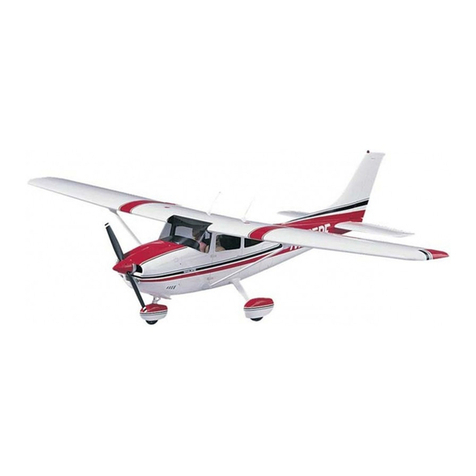
Top Flite Models
Top Flite Models Cessna 182 Skylane User manual

Top Flite Models
Top Flite Models Spitfire User manual
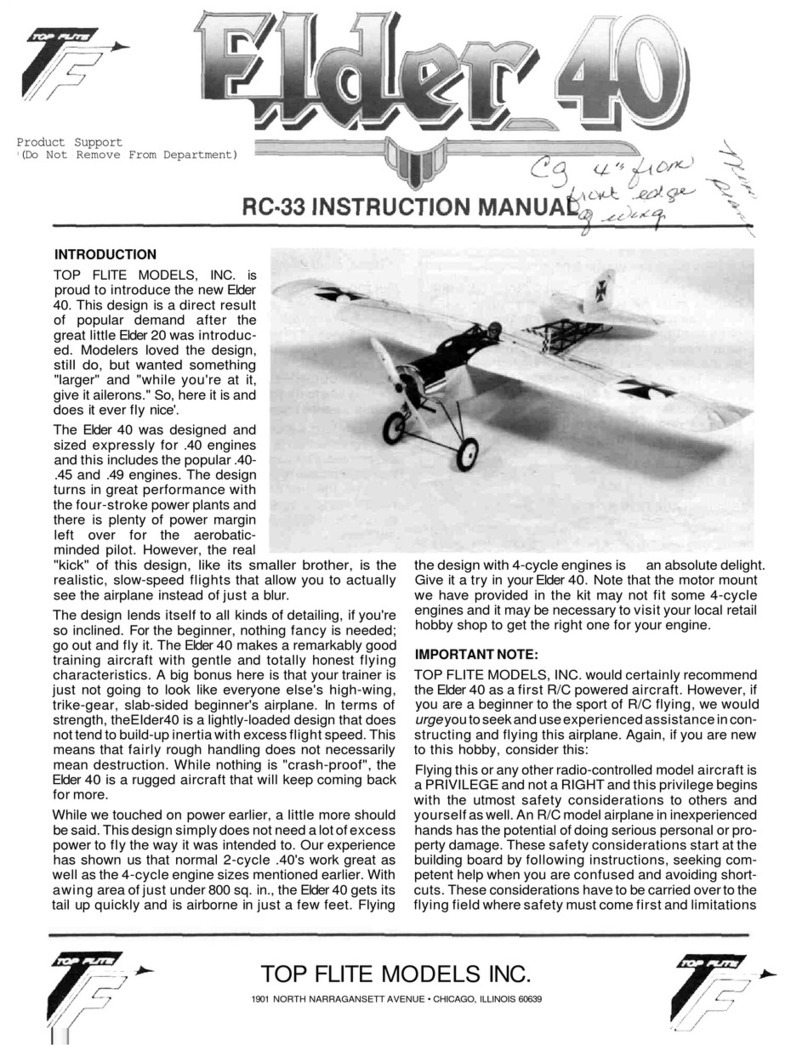
Top Flite Models
Top Flite Models RC-33 Elder 40 User manual
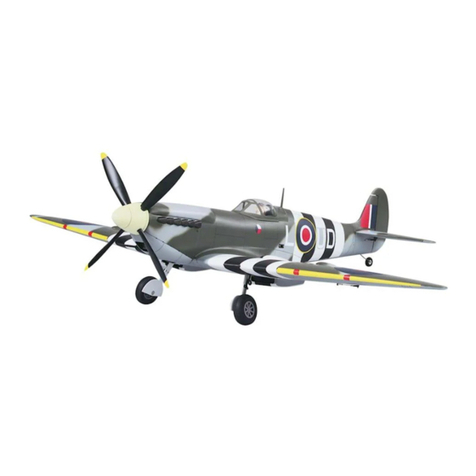
Top Flite Models
Top Flite Models SPITFIRE Mk IX User manual
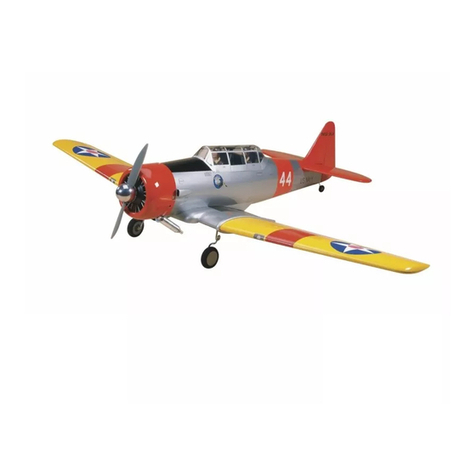
Top Flite Models
Top Flite Models AT-6 Texan User manual
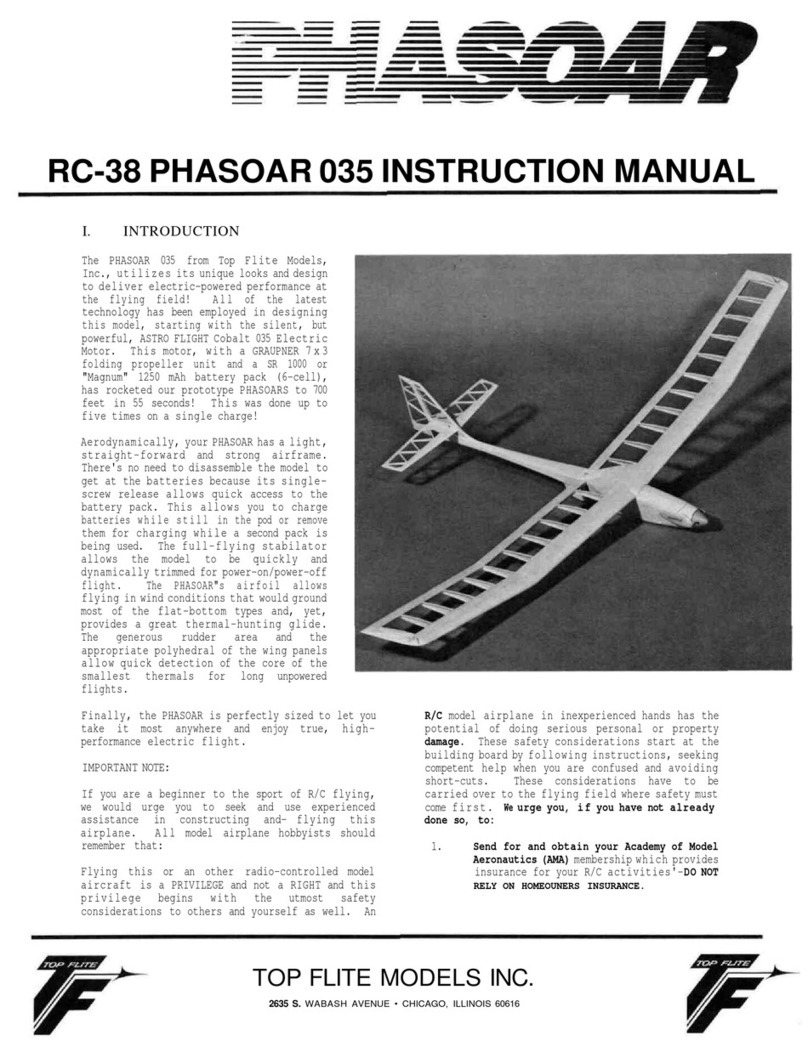
Top Flite Models
Top Flite Models PHASOAR 035 RC-38 User manual
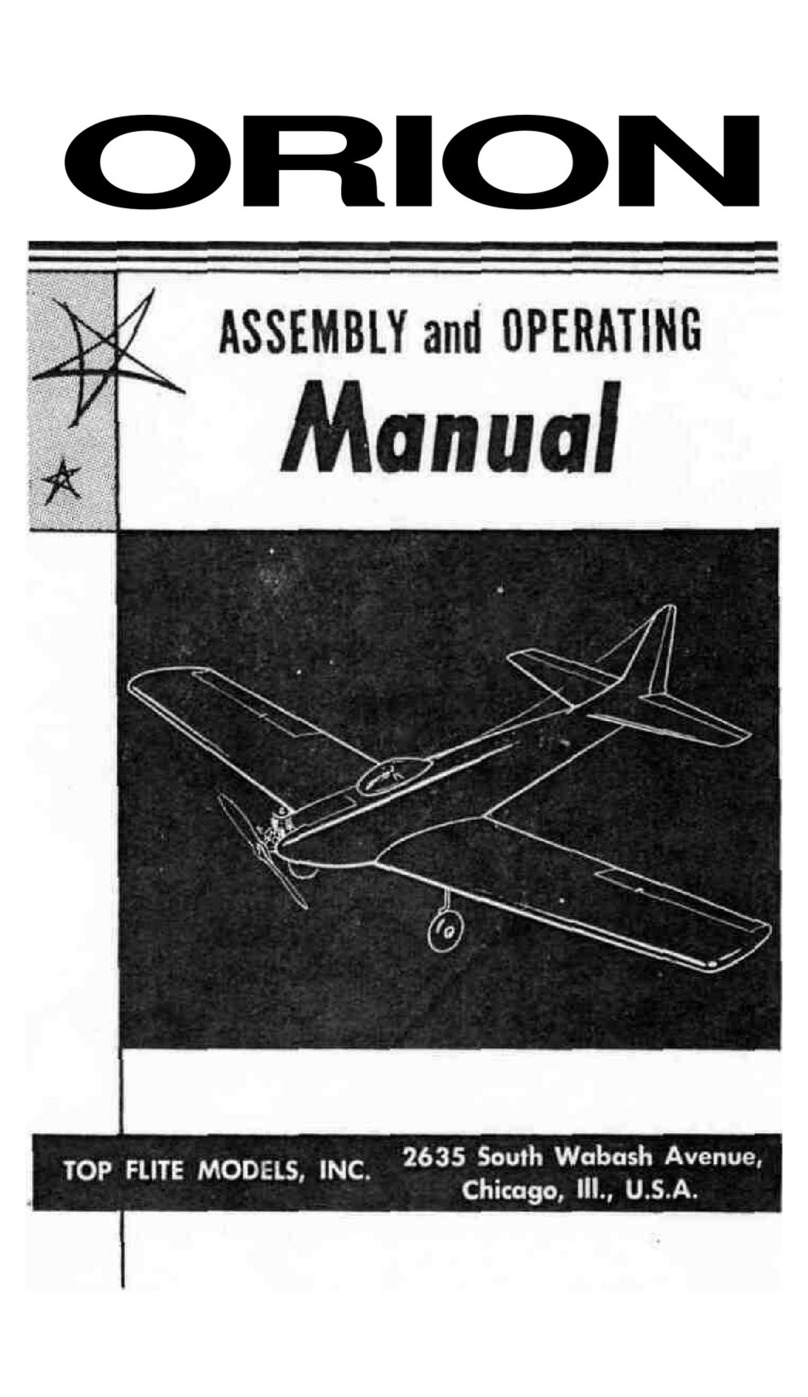
Top Flite Models
Top Flite Models ORION User instructions
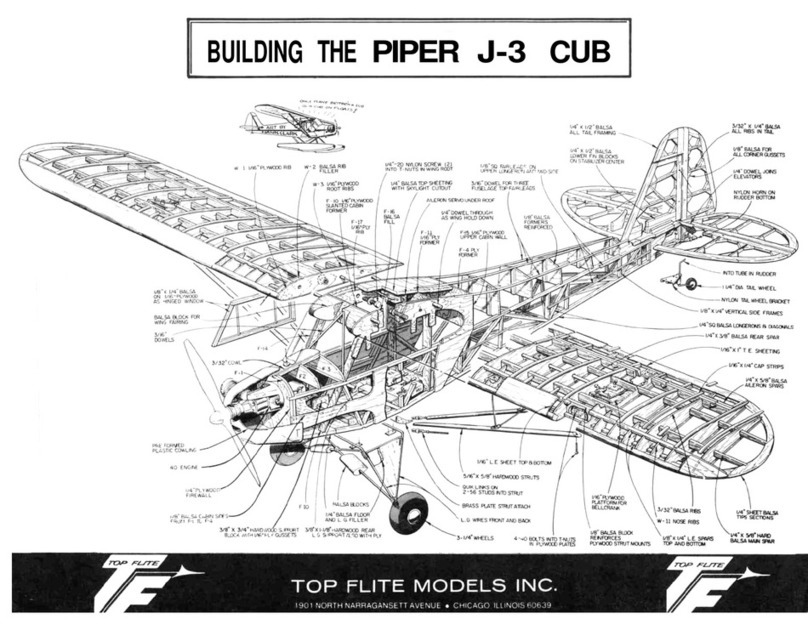
Top Flite Models
Top Flite Models Piper J-3 Cub User manual
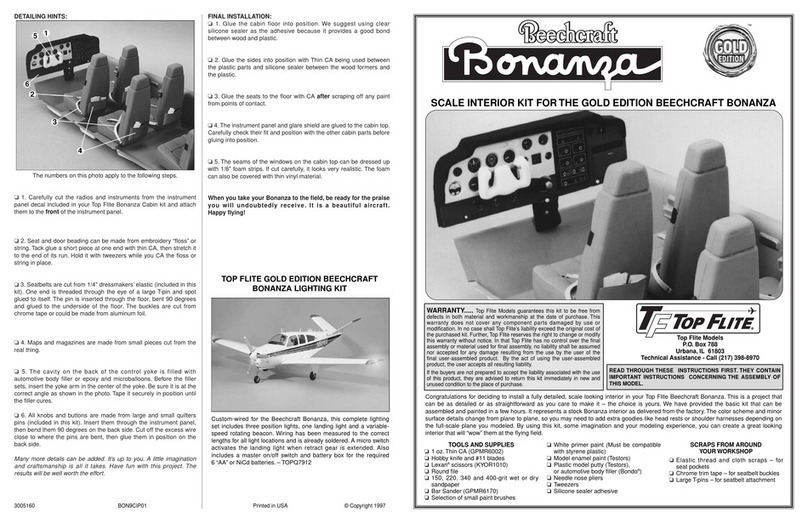
Top Flite Models
Top Flite Models GOLD EDITION Beechcraft Bonanza User manual
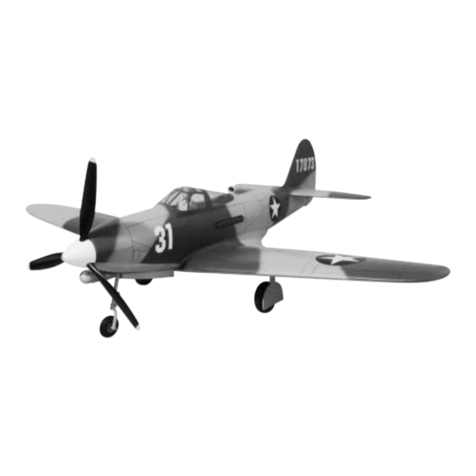
Top Flite Models
Top Flite Models P-39 AIRACOBRA User manual
